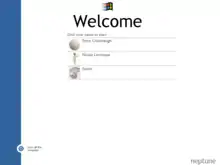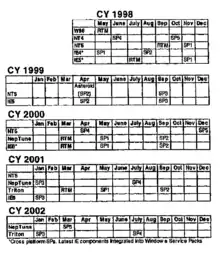| Version of the Windows NT operating system | |
 | |
 Neptune build 5111's desktop | |
| Developer | Microsoft |
|---|---|
| Working state | Historic, never released |
| Latest preview | 5.00.5111 (kernel reports) 5.50.5111 (version in many files) / December 27, 1999[1] |
| Marketing target | Consumer |
| Kernel type | Windows NT |
| License | Non-disclosure agreement[2] |
| Support status | |
| Cancelled | |
Neptune was the codename for a version of Microsoft Windows under development in 1999. Based on Windows 2000, it was originally to replace the Windows 9x series[3] and was scheduled to be the first home consumer-oriented version of Windows built on Windows NT code. Internally, the project's name was capitalized as NepTune.[4]
History

Neptune largely resembled Windows 2000, but some new features were introduced. Neptune included a logon screen similar to that later used in Windows XP.[2] A firewall new to Neptune was later integrated into Windows XP as the Windows Firewall. Neptune also experimented with a new HTML and Win32-based user interface originally intended for Windows Me,[5][6] called Activity Centers, for task-centered operations.[7][8]
Only one alpha build of Neptune, 5111, was released to testers under a non-disclosure agreement,[2] and later made its way to various beta collectors' sites and virtual museums in 2000.[9][10] Other builds of Neptune are known to exist due to information in beta builds of Windows Me and Windows XP. In November 2015, a build 5111.6 disk was shown in a Microsoft Channel 9 video; version 5111 was the last build of Neptune that was sent to external testers, with the .1 or .6 after the build number stands for variant, not for compile. It is the only build of Neptune that made its way to the public. Build 5111 included Activity Centers, which could be installed by copying ACCORE.DLL from the installation disk to the hard drive and then running regsvr32 on ACCORE.DLL.[11][12] The centers contained traces of Windows Me, then code-named Millennium,[13] but were broken due to JavaScript errors, missing links and executables to the Game, Photo, and Music Centers. In response, some Windows enthusiasts have spent years fixing Activity Centers in build 5111 close to what Microsoft intended.[14][15]
In early 2000, Microsoft merged the team working on Neptune with that developing Odyssey, the successor to Windows 2000 for business customers. The combined team worked on a new project codenamed Whistler,[16][17] which was released at the end of 2001 as Windows XP.[18][19] In the meantime, Microsoft released Windows Me in 2000 as their final 9x series installment.[17] Some development builds of Whistler feature an improved version of the logon screen found in Neptune build 5111.
Triton

Neptune was intended to have a successor named Triton, which was to be a minor update with very few user interface changes; service packs were additionally planned for it.[20][21] Triton was slated for a spring 2002 release (coinciding with Microsoft's final fiscal quarter of 2001). Triton was devised back in 1998 alongside Neptune; the only details of it within Microsoft's internal planning documentation that year relates to a deadline for added hardware support by December 2001.[20]
According to Paul Thurrott, the timeline of releases was Windows NT 5.0 (the codename for Windows 2000) for high-end workstations and Windows 98 for entry-level and mid-range PCs from 1998 to 1999; followed by Neptune in 2000 and 2001 for both workstations and consumer PCs; followed by Triton for the same target audience.[20] However, according to Charlie Kindel, Triton was to be a version of Neptune centered on home server usage.[22]
The project's codename refers to Neptune's largest moon, Triton.
See also
References
- ↑ Thurrott, Paul (6 October 2010). "The Road to Gold: The development of Windows XP Reviewed". SuperSite for Windows. Penton Media. Retrieved 12 August 2014.
- 1 2 3 Thurrott, Paul. "Windows XP: The Road to Gold". SuperSite for Windows. Archived from the original on 2007-01-24. Retrieved 2010-01-06.
- ↑ "Neptune - the new Windows". ZDNet. July 5, 1999. Archived from the original on 25 July 2008. Retrieved 2010-01-07.
- ↑ "Platforms Group - Desktop Three-Year Outlook" (PDF). Microsoft Corporation. February 1998. Retrieved 2010-01-08.
- ↑ "Activity Centers: A Windows Me Technology Showcase". winsupersite.com. Archived from the original on 10 July 2011.
- ↑ "Activity Centers Preview". winsupersite.com. Archived from the original on 22 July 2011.
- ↑ "Microsoft Cancels Neptune, Readies 'Whistler'". betanews. January 25, 2000. Retrieved 2010-01-07.
- ↑ "SuperSite Flashback: Neptune". winsupersite.com. Archived from the original on 9 August 2013.
- ↑ The Windows that Never Was… at theopenbracket.net
- ↑ DigiBarn Screen Shots: Windows XP Neptune Build 5111 DigiBarn Computer Museum
- ↑ "Windows Neptune/5.5.5111.1". betaarchive.com.
- ↑ Rob Jansen. "Builds • The Collection Book". thecollectionbook.info.
- ↑
- ↑ "View topic - Neptune's Activity Center... - BetaArchive". betaarchive.com. Archived from the original on 25 July 2014.
- ↑ Activity Center ACCORE.DLL Partial Fix. YouTube. 13 June 2014. Archived from the original on 2015-07-09.
- ↑ "Microsoft combines Neptune, Odyssey into Whistler". CNN. January 27, 2000. Archived from the original on September 1, 2008. Retrieved 2010-01-06.
- 1 2 "Microsoft consolidates Windows development efforts". ZDNet. January 25, 2000. Archived from the original on 14 March 2012. Retrieved 2010-01-06.
- ↑ "Windows XP Preview". TweakTown. August 21, 2001. Archived from the original on 2009-08-05. Retrieved 2010-01-06.
- ↑ Christopher Jones (April 2002). "Written Direct Testimony of Christopher Jones". State of New York v. Microsoft Corporation. Archived from the original on 23 October 2007. Retrieved 2006-01-07.
- 1 2 3 Thurrott, Paul (August 22, 2019). "Programming Windows: More Roads Not Taken". Thurrott. Archived from the original on October 22, 2020. (subscription required)
- ↑ "Platforms Group-Desktop Three-Year Outlook February 1998" (PDF). Retrieved 17 April 2023.
- ↑ Kindel, Charlie (August 8, 2011). "After 21 Years: Goodbye Microsoft". Kindel.com. Archived from the original on August 9, 2011.